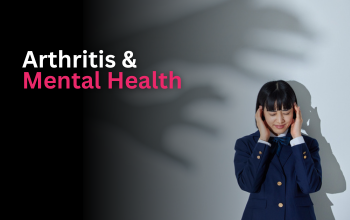Hidden Risk: How an Undiagnosed Condition Led to a Lifetime of Arthritis
 Michèle Ruggles was 55 when she found out she had been living with Ehlers-Danlos Syndrome since birth – a genetic connective tissue disorder that can lead to arthritis.
Michèle Ruggles was 55 when she found out she had been living with Ehlers-Danlos Syndrome since birth – a genetic connective tissue disorder that can lead to arthritis.
“When I think of my childhood, I was awkward, clumsy and always falling,” Michèle said. “People called me a klutz – it was a nickname that stuck.”
Individuals with Ehlers-Danlos can easily hyperextend their joints and have excessively stre
tchy skin. To prevent arthritis, protecting joints and avoiding injuries and falls is extremely important.
Michèle didn’t know she had Ehlers, so prevention was never on her radar. She played competitive sports, fell a lot, sprained and broke her ankles, experienced ligament injuries, a hiatal hernia at age 13 and more. Doctors simply dismissed her ongoing aches and pains as growing pains.
Coincidental Diagnosis
It wasn’t until years later, when her daughter dislocated her shoulder, that she finally had answers to all her own medical problems. An orthopedic surgeon fixed her daughter’s shoulder, but at a six-month follow-up appointment, realized the shoulder wasn’t where it should be.
“My daughter was referred to a geneticist. It was suggested that I accompany her to the appointment, and we were both diagnosed with Ehlers-Danlos Syndrome,” Michèle said. “I was so excited that I called my childhood friend and told her I finally had an explanation for my clumsiness! I felt relieved.”
Though Michèle’s son has not formally been diagnosed, he also scores very high for hypermobility on the Beighton Scale. The Beighton Scoring System is a set of maneuvers used to judge if there is evidence of joint hypermobility. There are nine points, and a score of four or more is considered a sign of there likely being generalized joint hypermobility present. Both Michèle and her daughter scored 9 out of 9. Ehlers is thought to have been inherited from Michèle’s father’s side of the family.
“I am certain my Dad had Ehlers, but he also did not know he had it,” she said.
The Aftermath of Undiagnosed Ehlers
Most of the joints in Michèle’s body are swollen and boney. She has osteoarthritis and has had a total hip replacement, the joint removed from her left thumb, her left ankle fused, is going to have both knees replaced this year and a right shoulder replacement will be scheduled next year.
“Looking back on my life, I wonder how it might be different today if doctors were educated about Ehlers,” Michèle said. “I could have probably had a less painful life because I would have chosen activities that weren’t as harmful.”
She hopes her own journey will benefit her children because they understand the condition and are careful about the activities they choose to do.
Even though Michèle wasn’t aware of it at the time, Ehlers-Danlos impacted many aspects of her life. She was forced to create her own job because a regular 9-5 was too demanding some days. She used to work with children who had disabilities but eventually she couldn’t lift them. Michèle decided to become a Greyhound agent.
“Unknowingly I was forced to make the decision to self-employ so I could give 100% on the days I could and allow my staff to ease my burden on the bad days,” Michèle said. “I made this change without really knowing why.”
Searching for Answers
Now, at age 65, Michèle is still searching for answers and wants people to know how serious arthritis can be.
“People make assumptions too quickly and don’t understand how painful this disease is,” she said. “I have discovered that you have to educate people because they don’t realize you can’t just take a pill and carry on.”
When it comes to managing arthritis, Michèle said adaptation is key.
“If your fingers don’t fit into the scissors you have anymore, find a new pair. If your hands are having a particularly bad day, hand wash your dishes. The heat from the water offers some relief and something is accomplished at the same time.”
Doctors recently discovered that Michèle had broken her left fibula months ago. Because of dealing with arthritis pain on a daily basis, it was just a new level of pain she attributed to the disease.
“I had no idea I had broken my leg, and it was only discovered accidentally with a pre-op x-ray for a total left knee replacement,” she said.
Michèle supports arthritis research 100 per cent for its potential to change lives.
“I realized when I was diagnosed that there are too many unknowns about arthritis and that research is needed to make peoples’ lives better,” she said. “Arthritis is not a ‘one size fits all’ nor a ‘one size fits most’ disease. It is complex, and I appreciate all those working in arthritis research who are trying to make life better for those afflicted with it.”
Message from Dr. John Esdaile, Arthritis Research Canada’s Scientific Director:
 Ehlers-Danlos Syndrome is now known to be 13 different hereditary diseases. There is about one case of Ehlers-Danlos for every 50 with rheumatoid arthritis or every five people with lupus. Features common to most of the 13 include very mobile joints that dislocate easily, skin that you see through, poor wound healing with a specific type of scars. Osteoarthritis is increased because of the lax joints which makes them especially susceptible to injury. The average family physician may see one case in their lifetime. Diagnosis requires a high level of suspicion by the doctor and then confirmation by genetic testing.
Ehlers-Danlos Syndrome is now known to be 13 different hereditary diseases. There is about one case of Ehlers-Danlos for every 50 with rheumatoid arthritis or every five people with lupus. Features common to most of the 13 include very mobile joints that dislocate easily, skin that you see through, poor wound healing with a specific type of scars. Osteoarthritis is increased because of the lax joints which makes them especially susceptible to injury. The average family physician may see one case in their lifetime. Diagnosis requires a high level of suspicion by the doctor and then confirmation by genetic testing.




















































